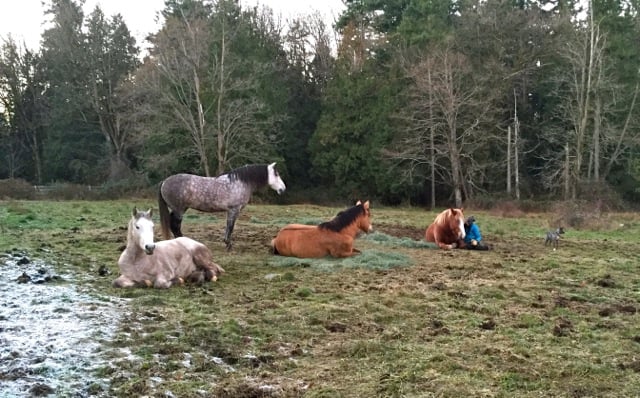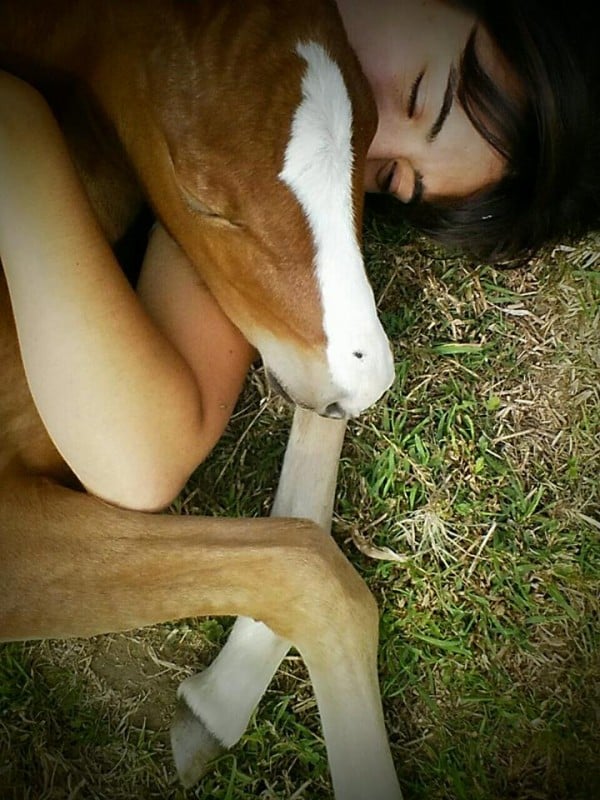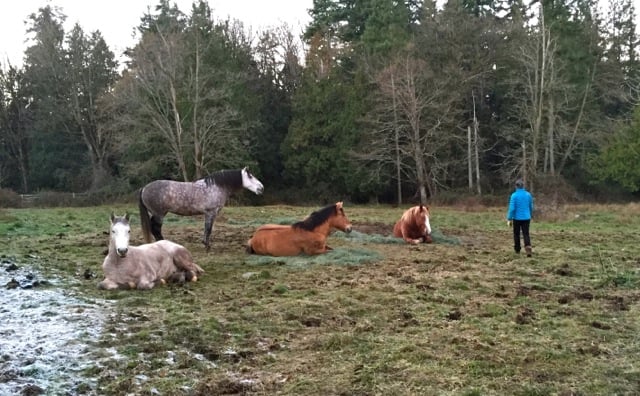Lying down with my horses is something I’ve done since I got my first horse at age 8. Some foals especially love to snuggle (others, not so much) – here’s a photo of my friend Kesia with little Firefly:
Of course, I didn’t realize how unusual or ‘special’ this was until I got older and out into the ‘horse world’. In fact, people were so taken by images of James French lying down with horses that this video went viral on Facebook (over 3.5 million views):
But it doesn’t change the fact that if your horse trusts you and feels peace in your presence, then your horse will enjoy resting or napping with you. Just like your dog or cat would.
Of course, if your horse is boarded at a busy stable or some other environment where peace is hard to come by, then that would make it pretty difficult to carve out a place to lounge around with your equine. But not impossible. You could either come really late at night, or super early in the morning – when people and activity will be at a minimum. Or, you can learn James French’s Trust Technique.
I purchased a membership to his online course (video tutorials) because I was curious to see how his technique differed from meditation. I would say the main difference between doing Trust Technique in the presence of your horse, and meditating, is the intention you set. When I meditate, my default intention (that I don’t consciously think about) is to descend into stillness, peace, and connection – with the Divine, earth, prana/chi.
With Trust Technique, the intention is to be fully in the present moment and to create a space where the animal can be fully present. The theory being that past trauma, abuse, etc. existed back then, but does not exist in the present. So if you can exist and the horse can exist fully in the present, then that is a healing space, where the past trauma can be released. And the way you do that is:
- Sit down in a place and position in which your body can be absolutely still and sit without moving, only breathing, for a couple of minutes.
- Then, focus your eyes on something near the horse, but not the horse’s body. Keep your eyes on that spot and let them go soft-focus (like when you stare off into space, or daydream). Do this for a couple minutes, along with remaining absolutely still in your body.
- Next, keep doing the body stillness and eye-focus, and now choose a sound to also focus on. It could be the wind, or a clock ticking, or birds chirping, etc. And focus only on that sound. Stay like this for as long as you can: your body absolutely still, your eyes soft-focus on a point or object, listening only for the sound you chose.
So you are not watching for your horse or his/her reaction and your horse may even walk away from you. Don’t worry about it, just keep practicing the technique until you can become fluent with it. And you may need to come out and do the Trust Technique with your horse numerous times before you are able to hold the present moment strongly enough, or your horse is ready to join you there.
I think the salient point to keep in mind here is that if you want to experience deeper intimacy and trust with your horse, rather than focusing on your horse, or working on your horse, you should focus on yourself. If you are a frantic energy, or stressed-out person, then horses aren’t going to want to come close to you – no matter how much time you spend sitting in their field.
Remember that horses are extremely sensitive to energy. So sitting quietly is not enough. You have to actually BE quiet – in your mind and your soul.
A trainer once told me about a woman who brought her mare in to be worked on. The woman had spent 6 months sitting in the mare’s field, waiting for the mare to come over and make contact, or connect with her in any way. Finally, she gave up and brought the horse in for natural horsemanship (pressure-release) training. The trainer’s point was that this horse was never going to choose to connect with the woman, so for some horses, force or pressure is needed.
Well, let me tell you, I boarded at the same facility as this woman for a few months and she was pretty frantic (energetically). A really nice, friendly woman, but her nervous system was cranked on high all the time. She was really stressful to be around! No wonder the horse didn’t want to come near her.
However, if this woman had learned how to meditate; how to down-regulate her own nervous system, release her stress, and begin to heal some of her own trauma, I’m pretty sure her mare would have connected to her in that field.
So if you find yourself in a similar situation. Pick a meditation technique, or use Trust Technique (get their online video course if you need more guidance and to see the process really broken down, step-by-step, along with interesting case studies), and go do it in your horse’s paddock or field. Forget about your horse and just learn how to enter stillness yourself. When you become – in your core – a grounded, peaceful person, your horse will trust you more and your relationship will naturally deepen and strengthen.

Also, note that when natural, empowered horses lie down – like the formerly semi-feral herd in these pictures – they do not lie close together, or touching each other. This is a family herd (same father) so they are very bonded, but they know that if a pack of coyotes, or a bobcat, comes out of the woods, they need to get up fast and they need space to rock and leap to their feet.
So then why would they enjoy a human lying on them, or smushed up against them? Some of mine don’t mind me being close, but unless I’m scratching their itchy bits, they are often more comfortable if I get my own spot and rest with them like a normal member of the herd. At times they have shown me the ultimate trust – by the entire herd lying down flat out in R.E.M. sleep, while I am entrusted to stay alert to keep the herd safe, and alert them to any danger. I take that trust very seriously.
So again, techniques and tools are good and can be fun, or interesting, but nothing beats simply listening to your horse! Each horse is different, with different likes and differing sensitivity levels – tune in and listen to your horse for their individual cues. If you ignore their cues, or you put the technique before the horse, you may end up with some problems like this woman.

Jini Patel Thompson is a natural health writer and Lazer Tapping instructor. She began riding at age 2 in Kenya, and got her first horse at age 8 in Alberta, and so continues a life-long journey and love affair with these amazing creatures.










Hi Jini, Thanks for sharing your brilliant blog. I’ve just discovered it and am enjoying catching up with past articles. I love this … thank you for sharing the Trust Technique and what it’s about.
I qualified last year as James French’s first advanced level practitioner and am loving sharing this way of connecting with and helping all our animals. One thing I’d love to add to your tips is that it’s really important to go at the horse (or other animal’s) pace. Making your ‘present moment’ stronger is not always the answer… going really slowly, stopping when they give us the queues to and giving animals time to process is a big part of the picture too. Especially if they’re sensitive and have a lot of trauma / anxiety to release. It makes them really feel heard and regarded by going at their pace, and is fantastic at building incredible trust, taking our relationships to new levels of connection. I love how subtle this work is, really learning to connect with our animals energetically. And how easy it is!
I know James is really busy and has a massive wait list for consults / clinics, but as I’m just starting up I am available for skype / phone / in person consults (yes, skype consults work really brilliantly for many international clients of mine!) so I’d love to share my website here if any of your readers want to know more about how to help their animal’s specific behaviour / emotional difficulty, or simply as you so rightly say, to connect deeper. With love and thanks for all you are sharing. Jacqui. http://www.jacquihowe.com
Great website Jacqui and your retreats look fabulous!
So beautiful to watch wonderful horses and wonderful man thankyou xxxx
Thank you Jini – your recommendation of the Trust Technique is great. I’d like to add that there is another element of the Trust Technique that really helps our animals to gain trust, confidence and release anxiety. That is completely regarding them and going at their pace. This is very subtle, and is perfect for sensitive animals. Often it isn’t that we need to make our ‘present moment’ stronger, it is that we are not giving animals enough time for processing. It is a magical moment when our animal friends really feel we are going at their pace. They begin to feel completely acknowledged on an energetic and feeling level. This is when true trust happens and our relationships are taken to another level completely. It’s like a soul connection, rather than just an emotional and physical one.
Very true Jacqui! And I’ve found they often need to walk away, or go do something else, to process. Then they come back and ask to have another go and it’s amazing how far they have progressed. Most horses WANT to make their world bigger, to heal, to have more experiences, more adventure. As you pointed out, we just need to slow down and they will actually get there much quicker! The 5 Minute Fun collaborative learning process works on these same principles:
https://www.listentoyourhorse.com/5-minute-fun-equine-collaborative-learning-method/
thanks Jini, sorry to comment twice – didn’t think the first one had submitted correctly 🙂
Thank you for posting this. I find it very interesting and have explored Jacqui’s website as well.
Jini, I’ve visited your site before and it’s always been enriching. I appreciate how much you shared in this post and also Jacqui’s addition; all of it, James French’s work and what you both speak of here reflect absolutely my own intuition. Thanks enormously for this and all you do!!
You’re so very welcome Rachel and thanks for saying Hi!
Hi thats so interesting! I did not know that you have learned the Trust Technique!
I have been thinking of doing it but its just SO expensive, the cheapest thing I could find on their site was even over my budget (25 usd) because I have just bought 2 horses and am counting pennies to get to eat every day.
Would it be possible for you to help out and write sth more on this technique within some frame (I guess it is not nice to give away ALL their “secrets”)
One of the horses is extremely relaxed and loving but spooks easily and bolts. If I spend time with him he gets all relaxed except he won’t be touched on the main near the ears. I can brush him tgere but if I lay my hand there even slightly, he seems to get annoyed, even stressed. Behind the ears I mean. In front is fine. He is not ear shy either.
He bolted and threw me off once already so I am not getting back on. Focusing on getting him relaxed and willing first. He’s the silent but explosive type. You know how some are right? They seem all cool but can bolt quite suddenly. All the tension is in his neck and I feel like he never lowers his head properly. He is an Icelander and so naturally won’t hang his head, they carry them high. But his tension definitely sits there and I think this causes him not to want to be touched much up there. I can lie under his belly and scratch him I mean he will even shut his eyes and enjoy massages and looks like he is falling asleep when we do our thing haha. He is extremely safe and cool in the pasture and I have never met a horse so LOVING. Its just if I introduce ANY pressure. He explodes. It is freakish. Almost like demon takes over.
I would love to test TT on him but I cannot possibly afford it. Any tips appreciated!!!
It sounds to me like he has been abused or traumatized in that area specifically. There are very sensitive nerves in the poll area. Perhaps try this tapping session and just change the words to fit his trauma/area:
https://listentoyourhorse.com/healing-for-angry-brutalized-horse-part-2-lazer-tapping/
There are also numerous ways you can meditate with him (which is all Trust Technique is):
PODCAST:
https://listentoyourhorse.com/ltyh-podcast-ways-to-meditate-with-your-horse-why-you-should/
MEDITATION VIDEO:
https://listentoyourhorse.com/guided-healing-meditation-in-the-big-barn/
What a wonderful journey you are embarking on with him and all the best xo
It sounds like your horse is accumulating “rabbits” (technically, trigger stacking) and cannot contain them anymore. He needs to learn how to calm himself, with your help in teaching him, so that the explosion never happens. Take a look. https://www.youtube.com/watch?v=nH1S6dpwrlw
Hi thank you for this. I have trouble understanding this technique as are you supposed to keep staring at the same spot even if your horse comes up to sniff you? As isn’t this ignoring them?
I am just confused as I feel bad when he comes to me and I am looking at the floor?
Well I think you would need to train in the technique to understand the elements and nuances of it. Although… whether you are ‘ignoring’ him, or allowing him to freely explore/express while you remain relaxed, is a matter of the energy and intention you hold. Hope that makes sense… 🙂
I just tried the trust technique with my 21 year old sweet gelding after watching some free introductory videos on James website. For a good 20 min he zoned out half asleep, ears involuntarily twitching, heavy breathing and a bit of drooling, eyes almost completely closed but all standing up. Will a horse always lay down to benefit from this? I am just curious if they will always eventually lay down….interestingly, the horse in the next pasture did lay down.
I guess it depends on whether their body wants a deeper sleep, or not. Also, the condition of their nervous system. Either way, it’s all good! Any relaxation or meditation the human does, benefits our animals immensely. When we down-regulate our own nervous system, the animal (horse, dog, cat, etc) instantly feels the shift to peace.